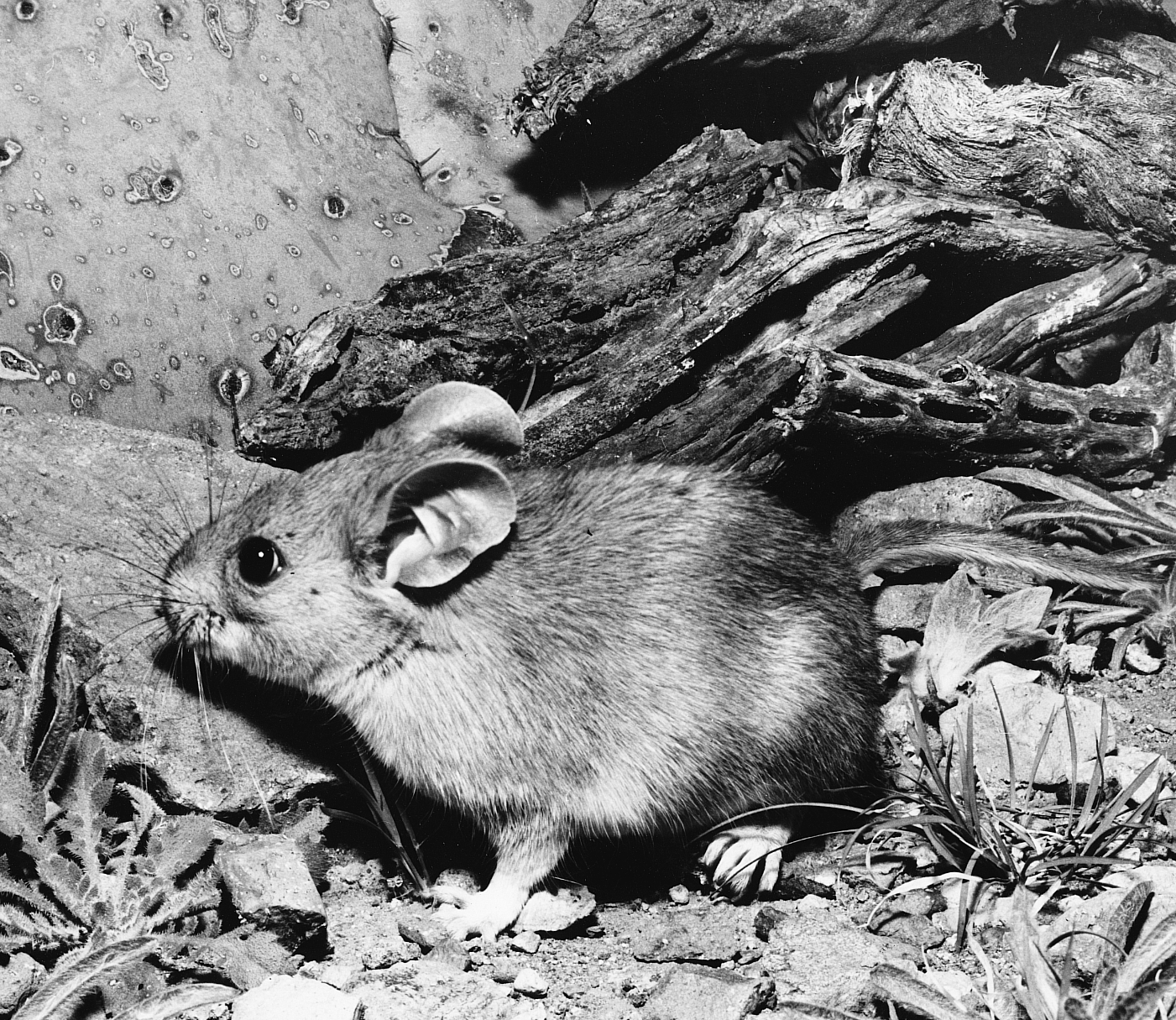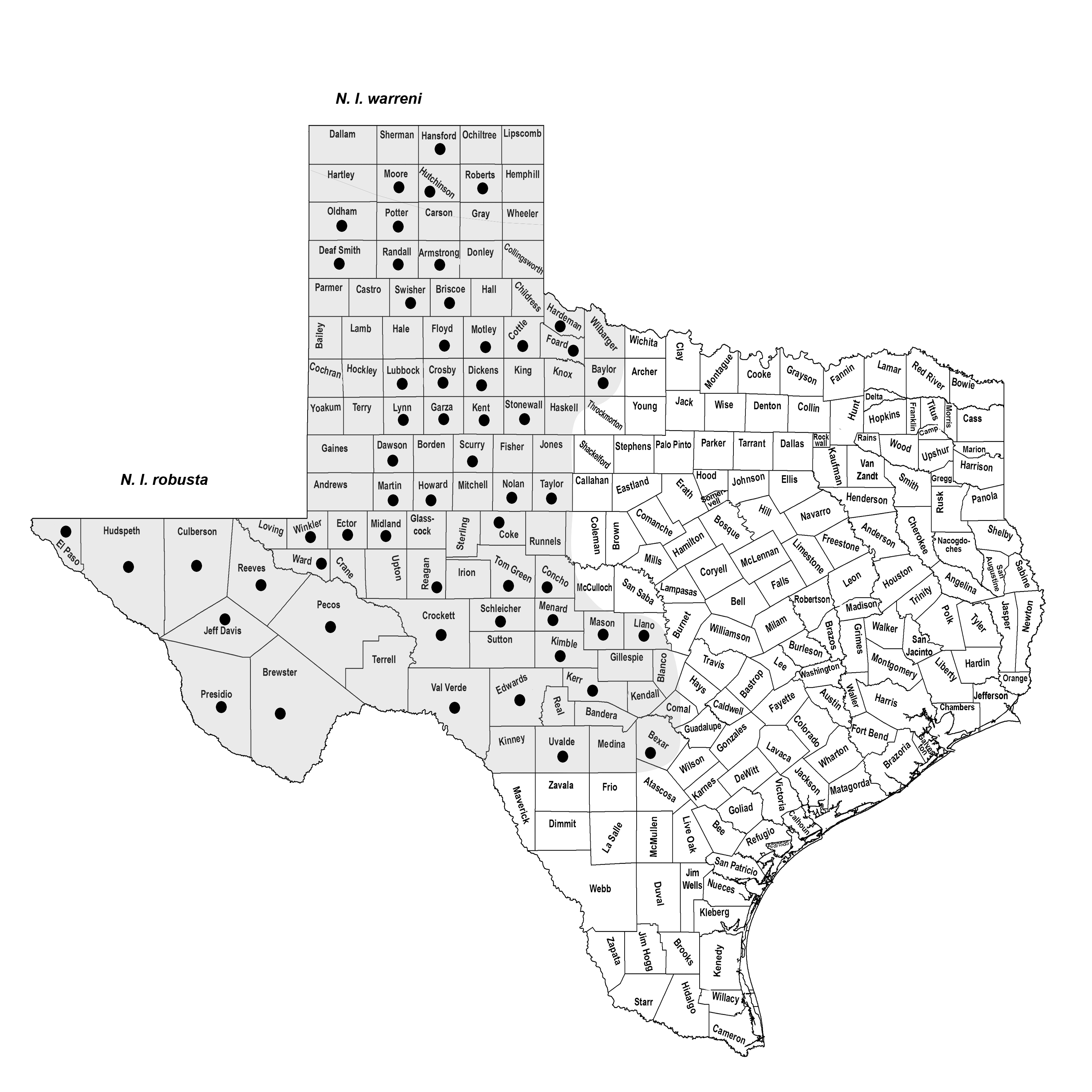WHITE-TOOTHED WOODRAT
Neotoma leucodon Merriam 1894
Order Rodentia : Family Cricetidae
DESCRIPTION. A medium-sized woodrat with large ears, bulging black eyes, and relatively short, distinctly bicolor tail (grayish brown above, white below), densely covered with short hairs; throat, and usually breast and chin, with hairs white to base; upperparts dull pinkish buff, brightest along sides, thinly suffused with blackish; underparts and feet white. Dental formula: I 1/1, C 0/0, Pm 0/0, M 3/3 × 2 = 16. Averages for external measurements: total length, 328 mm; tail, 152 mm; hind foot, 34 mm. Weight, 136–294 g.

DISTRIBUTION. Found in the Panhandle and broken country south of the Red River throughout the Edwards Plateau to Bexar and Uvalde counties and westward over most of the southwestern part of state.

SUBSPECIES. Neotoma l. warreni in the northern Panhandle and N. l. robusta over the remainder of the range.
HABITS. This woodrat is known to reside at intermediate elevations primarily in arid lands of the Trans-Pecos, along the rocky slopes of the escarpment surrounding the Llano Estacado, and rocky areas on the Edwards Plateau. It seems to be especially fond of desert scrub vegetation such as prickly pear, cholla cactus, mesquite, sotol, lechuguilla, and creosote bush, and of juniper breaks. Cholla cactus and prickly pear offer preferred midden sites because they supply not only protection but also food and water. Occasionally, their middens are built in the open or in sparse vegetation. In rocky situations, the associated cracks and crevices afford the usual den site.
The midden is a crude cone of sticks, cactus joints, and other rubbish surrounding the nest proper, a compact, cup-shaped structure composed of shredded dry leaves, blades of grass, and weed stems. Access to the midden is by means of openings near the base to which well-worn trails lead. Frequently, especially in localities where building materials are scarce, the midden is supplemented by a system of underground burrows. Feces are not deposited within the den or midden; instead fecal material is usually deposited in a single area outside the midden but in the vicinity of the midden.
Although several middens may occupy a small, desirable patch of cacti, the rats are not social creatures. Only one animal or a female and her young occupy each house. Their home ranges or feeding territories overlap considerably, but middens are not shared.
The diet of these woodrats consists of a variety of desert plants, but the cactus family led the list of over 30 items found in the stomachs of 360 rats examined. Mesquite and forbs were next in preference. Grasses constituted <5% of their fare, but small quantities were regularly consumed. The amount of animal material consumed (ants, birds, beetles, and grasshoppers) was <1% of the total diet. The habit of storing food is not well developed in these rats, but small quantities of food are usually found at each midden. Drinking water is not required because of the high water content in their choice of foods.
Breeding may extend throughout the year in parts of Texas, but the primary season is from January to September. At least two, and possibly three or more, litters of two or three young each may be reared during this period. The period of gestation is approximately 30 days. At birth the young are helpless, weigh about 11 g, and are about twice the size of newborn house rats. As is the case with other woodrats and many related species of mice, the pups have specially developed front teeth that permit them to grasp the nipples of the mother and to be dragged along behind her, skidding and bouncing along on their backs, when she leaves the nest. They grow rapidly; the ears open on the 13th to 15th day, the eyes open on the 15th to 19th day, and they are weaned when 62–72 days old. When about 6 months old they are almost indistinguishable from the adults.
The spiny fortress that surrounds the midden, coupled with the nocturnal habits of the rats, makes them relatively safe from most predators. Owls catch a few individuals, as do coyotes, bobcats, ringtails, and weasels, but their chief natural enemies appear to be the large desert gopher snake and the rattlesnake.
POPULATION STATUS. Common. The white-toothed woodrat is common throughout its range in Texas.
CONSERVATION STATUS. The IUCN lists the white-toothed woodrat as a species of least concern, and it does not appear on the federal or state lists of concerned species. This species does not face any serious conservation threats.
REMARKS. In previous editions, this species was referred to as Neotoma albigula. In 2001, Cody Edwards and RDB at Texas Tech University, using techniques of molecular genetics, demonstrated a distinct genetic division between populations of white-toothed woodrats located east and west of the Rio Grande in New Mexico. Those populations east of the Rio Grande represent a different species, N. leucodon, from those west of the river, N. albigula. This is the logic for assigning all Texas populations to the species N. leucodon.
From The Mammals of Texas, Seventh Edition by David J. Schmidly and Robert D. Bradley, copyright © 1994, 2004, 2016. Courtesy of the University of Texas Press.
Natural Science Research Laboratory
-
Address
Museum of Texas Tech University, 3301 4th street, Lubbock, TX 79409 -
Phone
806.742.2486 -
Email
nsrl.museum@ttu.edu

